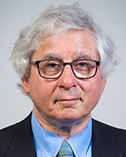
Paul DiMaggio
New York University
|
Primary Section: 53, Social and Political Sciences Membership Type:
Member
(elected 2022)
|
Biosketch
Paul DiMaggio is a sociologist whose work has examined topics at the intersection of the study of culture and research on social organization. His research has addressed such topics as the impact of cultural capital on educational attainment; the emergence of high culture in the United States; causal mechanisms tending to increase homogeneity among organizations within industries; the impact of social networks on consumer purchases; polarization of political attitudes in the United States; inequality in access to and use of the Internet; the impact of homophily and network externalities on intergroup inequality; and the use of computational text analysis as a tool for sociologists of culture. DiMaggio was born in Philadelphia, and grew up in southern New Jersey. A graduate of Swarthmore College, he received his M.A. and Ph.D. in Sociology from Harvard University. Between 1979 and 1992 he was Assistant Professor through Professor in the Sociology Department at Yale University. Between 1992 and 2016 he was Professor of Sociology at Princeton University (from 2008 to 2016, A. Barton Hepburn Professor of Sociology and Public Affairs). He is currently Professor of Sociology at New York University, where he also holds affiliated-faculty status in the Center for Data Science, the Stern School of Business and the Wagner School of Public Service. DiMaggio is a member of the American Academy of Arts and Sciences, the American Academy of Political and Social Science, the American Philosophical Society, and the National Academy of Sciences.
Research Interests
DiMaggio's current research focuses on Americans' attitudes towards science and religion. The work has evolved from earlier research in the sociology of culture, political polarization in the U.S., and methods for identifying population heterogeneity in survey data. Whereas much writing has depicted science and religion as antagonistic realms of belief, we are learning that, although some Americans have positive attitudes towards one of these institutions and negative views of the other, different but meaningful patterns exist. In addition to using standard survey items tapping attitudes towards university-based science and organized religion, our survey introduced two additional scales, eliciting views of non-institutionalized counterparts of scientific and religious institutions (populist science and spiritualism, respectively). We are currently working on three papers. One reports on the varying patterns of belief that Americans hold, and examines the consequences of these beliefs for trust in science and religion and related policy preferences. A second (in collaboration with the Banaji lab at Harvard) explores the relationship between implicit and explicit attitudes (especially identification and attributed credibility) toward science and religion, with special attention to persons whose implicit and explicit attitudes are misaligned. A third exploits data on conversations about scientific and religious topics, respectively, to examine the nature of interpersonal communications about science and religion: Who does and does not talk with others about science or religion? What are these conversations about? Who are their interlocutors? And how is this associated with dispositions toward these two domains? Further studies will follow that we hope will be useful in finding common ground.

